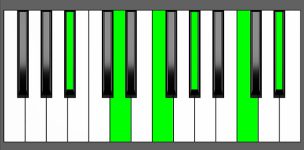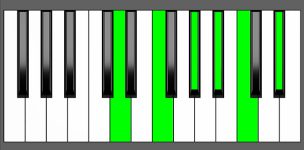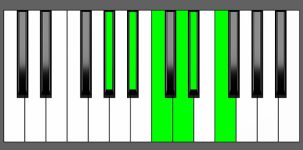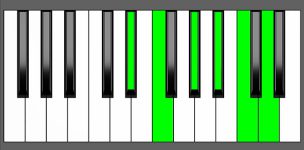Piano Diagram of A#11 in Root Position
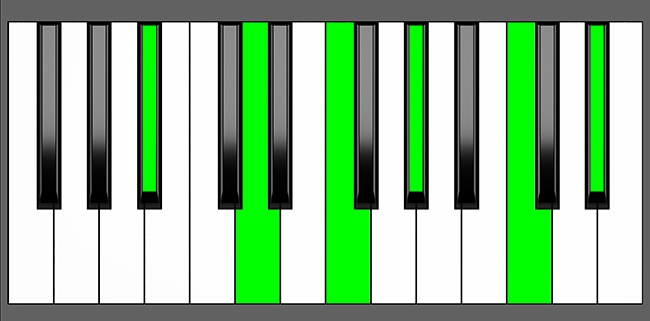
A#11 is a chord that includes the root note A#, the major third (Cx), the perfect fifth (E#), the minor seventh (G#), the major ninth (B#), and the eleventh (D#). Keep reading to learn something more about this chord.
Structure of A#11
Notes |
|---|
| A#, Cx, E#, G#, B#, D# |
Intervals |
|---|
| R, 3, 5, m7, 9, 11 |
Playing Extended Chords on Piano
Extended chords are commonly used in piano playing, but they can be tricky to play in their entirety due to the large number of notes involved. To make these chords more manageable, pianists often omit certain notes, such as the root or the 5th. Another technique is to split the chord between both hands, playing either full or partial chords in each hand.
How to play an A#11
For example, to play the A#11 chord, you can start by playing the root note A# with your left hand. Then, with your right hand, you can play the major 3rd Cx, minor 7th G#, and the 11th note D#. This will result in a simplified A#11 chord that consists of the root note, major 3rd, minor 7th, and the 11th notes only.
A# + Cx, G#, D#
However, even when notes are omitted or split between hands, extended chords can still create complex and dense harmonies. When these chords are inverted, the resulting clusters of notes can be particularly challenging to voice effectively.
A#11 Chord Inversions
The A#11 chord has a total of 5 inversions:
| Root Position: | A# | Cx | E# | G# | B# | D# |
| 1st Inversion: | Cx | E# | G# | A# | B# | D# |
| 2nd Inversion: | E# | G# | A# | B# | Cx | D# |
| 3rd Inversion: | G# | A# | B# | Cx | D# | E# |
| 4th Inversion: | B# | Cx | D# | E# | G# | A# |
| 5th Inversion | D# | E# | G# | A# | B# | Cx |
Piano Keyboard Diagrams
Chord Inversions on Piano
Understanding chord inversions is an essential aspect of music theory as it helps to explain how chords are constructed and used in progressions. When playing chord inversions on a piano, it’s important to keep in mind that the diagrams used to illustrate the order of notes may not always be practical to play.
To achieve the proper chord voicings on a piano, you need to distribute the notes of the chord across various octaves and positions on the keyboard. This often means that the basic shape of the chord’s inversions shown in diagrams may not be the most convenient or comfortable way to play the chord.
While chord inversion diagrams can be useful in comprehending the structure and sequence of notes in a chord, it’s recommended to experiment with different voicings and fingerings to find the most efficient and comfortable way to play the chord while still preserving its intended harmonic function and sound.
Music Theory and Harmony of A#11
The A#11 chord is an extension of the A#7 chord and is commonly used on the V and VII degree of major and natural minor scales, respectively. It can be used in all the positions where A#7 can be played, but a more common use is to play it in conjunction with an A#7 chord. However, it’s important to note that some positions may not work as well as others when using A#11 instead of A#7.
If you want to experiment with using A#11 as an alternative to A#7, you can start by checking out the A#7 chord page for ideas on where to begin. Trying out the A#11 chord in different positions can help you understand which ones work well and which ones may not be as effective.
Building the A#11 Chord: Different Approaches
Starting from the A# Major Scale
To form an 11th chord, you combine the root, the major 3rd, the 5th, the minor 7th, the major 9th and the 11th from a major scale:


To create an A#11 chord, apply the formula R, 3, 5, m7, 9, 11 in the following manner:
- Begin with the Root note, A#.
- Select the major 3rd interval, Cx.
- Add the 5th interval, which is E#.
- Add the minor 7th interval, G#.
- Add the major 9th, which is a 2nd at the higher octave, B#
- Lastly, add the 11th D#, which is a 4th interval at the higher octave.
By following this simple formula, you can create a dominant 11th chord from any major scale.
by Combining Intervals
One method to create a dominant 11th chord is by combining specific intervals – a major 3rd, a minor 3rd, a minor 3rd, a major 3rd and a minor 3rd. This is the formula:
3 + m3 + m3 + 3 + m3 = 11th Chords
To build an A#11 chord,
- we begin with the root note A# and
- add a major 3rd interval, which is four half-steps up from A#, to get Cx.
- Next, we add a minor 3rd interval, which is three half-steps up from Cx, to get E#.
- Continuing in this pattern, we add another minor 3rd interval to get G# and
- then a major 3rd interval to get B#.
- Finally, we add the 11th note (D#), which is a minor 3rd higher than B# to complete the chord.
by Combining Chords
An alternative way to build dominant 11th chords is to merge a major triad with the major chord based on its minor 7th.
To form an A#11 chord, for instance, you can blend an A# Major triad (A#, Cx, E#) with a G# Major chord (G#, B#, D#).
A# Major + G# Major = A#11
When played together, these two chords produce an A#11 chord.
How to Use A#11 in a Chord Progression
The A#11 chord is essentially an extension of the A#7 chord, with the addition of the 9th (B#) and the 11th (D#) notes. As the A#11 chord includes the dominant 7th note (G#), it serves a similar function to the A#7 chord in creating tension and leading to the tonic chord.
Because of this, the A#11 chord can often be substituted for the A#7 chord and vice versa, depending on the desired musical effect. While there are examples of 11th chords used as tonic chords, this post will focus on the more common uses of the A#11 chord.
These tables show the harmonized major and natural minor scale where you can find an A#7 that can be replaced by an A#11 but I suggest referring to the posts on dominant 7th chords to learn more fancy uses and contexts in which a dominant 9th chord can be played.
It’s important to keep in mind that D# Major and B# minor are considered theoretical keys and not commonly used in practice. This is mainly due to their complex nature, with a high number of accidentals. It’s more convenient to refer to their enharmonic equivalent keys (Eb Major and C minor), as they involve fewer accidentals.
on D# Major Scale
| Major Scale | I | ii | iii | IV | V | vi | vii |
|---|---|---|---|---|---|---|---|
| D# = Eb | Eb Maj7 | F min7 | G min7 | Ab Maj7 | Bb7 ⇒ Bb11 = A#11 | C min7 | Dm7b5 |
- Dominant chord in Eb Major as Bb11
on B# minor Scale
| Natural Minor | i | ii | III | iv | v | VI | VII |
|---|---|---|---|---|---|---|---|
| B# = C | C min7 | Dm7b5 | Eb Maj7 | F min7 | G min7 | Ab Maj7 | Bb7 ⇒ Bb11 = A#11 |
- Leading Tone chord in C minor as Bb11
A#11 as Dominant Chord in D# Major
A#11 as the Leading Tone chord in B# minor
Alternative A#11 Nomenclature
- A# 11
- La# 11
- A# 11th
- A# dom11
- A# 7/9/11
- A# dominant 11
- A# dominant 11th
- A# dominant eleventh
- A# dominant ninth eleventh
- A# dominant seventh ninth eleventh
